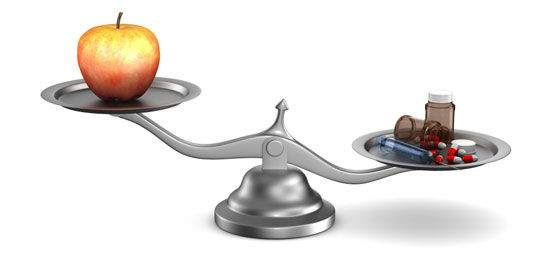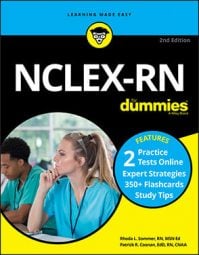 © Ilin Sergey / Shutterstock.com
© Ilin Sergey / Shutterstock.comWhat to do when the body systems are out of whack
Any body system can be altered for better or worse, so this section is a very broad topic. Remember that the main body systems include cardiac, respiratory, endocrine, neurologic, musculoskeletal, immune, genitourinary, gastrointestinal, reproductive, and integumentary. When prioritizing care for alterations in any body system, always remember to put physiological needs first.Test questions on body system alterations include questions on adults and children. Here are some examples:
Practice question
A client comes into the emergency room with complaints of dizziness, nausea, and vomiting. The doctor suspects Ménière’s disease. What is the nurse’s priority action?(1) Give an antiemetic
(2) Initiate a sodium-restricted diet
(3) Give an antihistamine
(4) Initiate safety measures
The keywords in this question are emergency room; dizziness, nausea, and vomiting; Ménière’s disease; and nurse’s priority action. The correct answer is Choice (4). A Ménière’s patient is at high risk for falls; therefore, safety measures need to be put in place. The other answers are interventions for this condition but aren’t a priority at this time.Practice question
A 21-year-old client has just been diagnosed with having a hydatidiform mole. Which of the following is considered a risk factor in developing this mole?(1) Age in 20 to 40 range
(2) Primigravida
(3) Prior molar gestation
(4) High socioeconomic status
The keywords for this question are 21-year-old client, hydatidiform mole, and risk factor in developing this mole. The correct answer is Choice (3). Prior molar gestation increases a woman’s risk for developing another molar gestation. Adolescents and women 40 and older are also at increased risk for molar pregnancies. Multigravidas, especially women with prior loss of pregnancies and women from lower socioeconomic classes, are at an increased risk.Practice question
When performing a neurologic assessment on a neonate, which sign is considered a normal finding?(1) A positive Babinski’s sign
(2) “Sunset” eyes
(3) Closed fontanels
(4) Pupils unreactive to light
Keywords for this question are performing a neurologic assessment, neonate, and normal finding. The correct answer is Choice (1). A positive Babinski’s sign is normal in infants up to one year of age but is abnormal in adults. Sunset eyes, where the sclera is visible above the iris, is a result of cranial nerve palsy and may indicate increased intracranial pressure. Fontanels do not completely close till 18 months. An infant’s pupils react to light in the same way that an adult’s pupils do.Practice question
Crohn’s disease is a chronic relapsing disease. Which area of the GI tract is involved with this disease?(1) The entire length of the large intestine
(2) The small intestine and colon, the entire thickness of the bowel
(3) The small intestine, mucosa only
(4) The sigmoid area only
The keywords for this question are Crohn’s disease, chronic relapsing disease, and which area of the GI tract is involved. The correct answer is Choice (2). Crohn’s disease may involve the large intestine, the small intestine, or both, and it affects the entire thickness of the bowel regardless. Choices (1) and (3) probably describe ulcerative colitis, and Choice (4) is too specific and a small part of the bowel; therefore, it isn’t a likely answer. In any body system alteration, when an answer involves a very specific part of the body, it’s probably an incorrect choice.Practice question
When assessing a client with a history of genital herpes, which of the following symptoms would indicate that an outbreak of lesions is imminent?(1) Headache and fever
(2) Vaginal and urethral discharge
(3) Dysuria and lymphadenopathy
(4) Genital pruritis and paresthesia
The keywords for this question are assessing a client, history of genital herpes, and following symptoms would indicate that an outbreak of lesions is imminent. The correct answer is Choice (4). Pruritis and paresthesia, as well as redness of the genital area, are symptoms of recurrent herpes infection. These symptoms appear anywhere from immediately before lesions appear to 48 hours prior. Headache and fever are symptoms of primary infection. Dysuria and lymphadenopathy are local symptoms of primary infection that may occur with recurrent infection, but don’t occur prior to the outbreak of lesions.Infection
Infection is an invasion of the body by pathogenic organisms that multiply and produce injurious effects. A communicable disease is an infectious disease that may be transmitted from one person to another. To prevent the spread of infection, you need to break the chain of events that leads to infection by doing the following:- Maintain a clean, dry, well-ventilated environment.
- Wash your hands — yes, between every client!
- Disinfect, maintain isolation when necessary, and use aseptic techniques.
- Use universal precautions — on everyone! (That’s why they’re called “universal.”)
Everything that happens, whether it’s related to nursing or not, starts with a chain of events. See the following figure for a visual example.
 An infectious illness chain of events.
An infectious illness chain of events.The following are typical questions related to infectious disease:
Practice question
Which of the following types of cases of pneumonia is most common in children ages 5 to 12?(1) Enteric bacilli
(2) Mycoplasma pneumonia
(3) Staphylococcal pneumonia
(4) Streptococcal pneumonia
Keywords for this question are types of cases of pneumonia and most common in children ages 5 to 12. The correct answer is Choice (2). Mycoplasma pneumonia is typically seen in older children. The other three are typically seen in children from 3 months to 5 years old.Practice question
Pneumococcal vaccine polyvalent and flu vaccination are highly recommended for clients with asthma, chronic bronchitis, and emphysema for which of the following reasons?(1) These vaccines prevent the patient from getting pneumonia or other serious respiratory infections.
(2) These vaccines help reduce the fast respiratory rates that these clients experience.
(3) These vaccines help reduce the need for maintenance medications for these conditions.
(4) All clients should have these vaccines.
The keywords for this question are pneumococcal and flu vaccination; recommended for clients with asthma, chronic bronchitis, and emphysema; and for which of the following reasons. The correct answer is Choice (1). Receiving vaccines to protect against respiratory infection is highly recommended for clients with respiratory disorders. Infections can cause these clients to need intubation and mechanical ventilation. Weaning may be difficult or impossible because the client’s respiratory system becomes dependent on the assistance provided by the ventilator. The vaccines have no effect on bronchodilation or respiratory rate.Practice question
An adult client has received an injection of immunoglobulin. The nurse knows that the client will develop which of the following types of immunity?(1) Active natural immunity
(2) Active artificial immunity
(3) Passive natural immunity
(4) Passive artificial immunity
Keywords for this question are adult client, injection of immunoglobin, and develop which of the following types of immunity. The correct answer is Choice (4). Passive artificial immunity occurs when antibodies are produced by another person or animal and injected into the recipient.Practice question
A patient is being admitted to the unit with a diagnosis of chickenpox, or varicella. The nurse needs to set up which transmission-based precautions for this patient?(1) Droplet
(2) Contact
(3) Airborne and contact
(4) Standard
This question’s keywords are a diagnosis of chickenpox, or varicella; needs to set up; and which transmission-based precautions. The correct answer is Choice (3). Chickenpox is transmitted by touching the rash or contaminated objects and by droplets.
